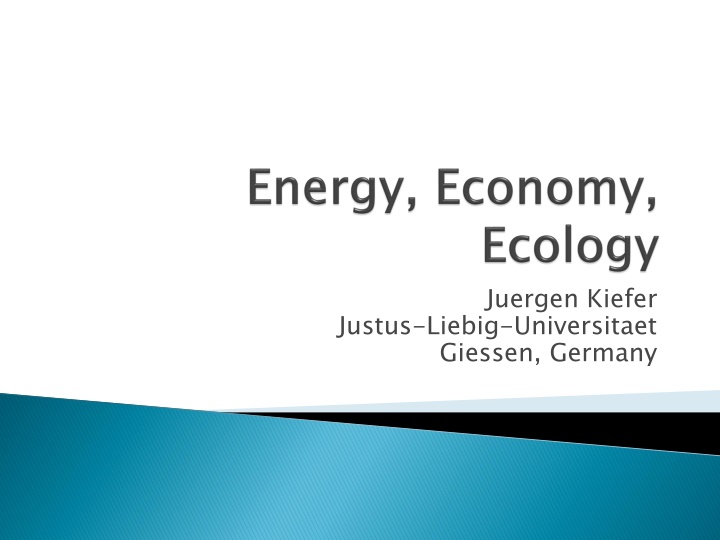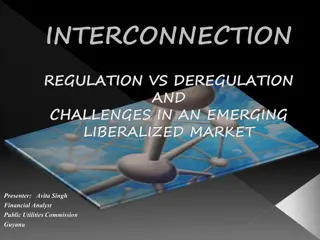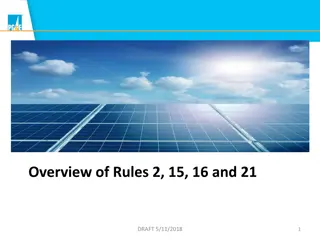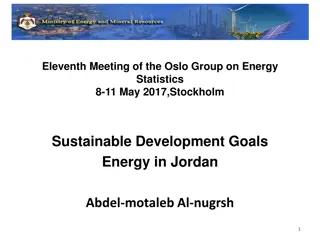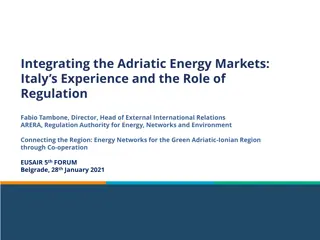The Interconnection Between Economic Growth, Energy Consumption, and Environmental Impact
The data presented highlights the relationship between economic output, energy consumption, and carbon dioxide emissions in various countries. It emphasizes the importance of sustainable practices to protect the environment and suggests transitioning to renewable energy sources as a solution to mitigate the impact of economic growth on global climate.
Download Presentation

Please find below an Image/Link to download the presentation.
The content on the website is provided AS IS for your information and personal use only. It may not be sold, licensed, or shared on other websites without obtaining consent from the author.If you encounter any issues during the download, it is possible that the publisher has removed the file from their server.
You are allowed to download the files provided on this website for personal or commercial use, subject to the condition that they are used lawfully. All files are the property of their respective owners.
The content on the website is provided AS IS for your information and personal use only. It may not be sold, licensed, or shared on other websites without obtaining consent from the author.
E N D
Presentation Transcript
Juergen Kiefer Justus-Liebig-Universitaet Giessen, Germany
60000 USA Singapore 50000 GNP /caput/ US dollars/year GNP /caput/ US dollars/year Germany UK 40000 France 30000 Italy 20000 10000 Russia Brazil China South Africa Nigeria Indonesia 0 Pakistan India 0 50 100 Energy consumption / GJ/caput/year 150 200 250 300 350 Energy consumption / GJ/caput/year http://data.worldbank.org/indicator/NY.GNP.PCAP.CD and https://en.wikipedia.org/wiki/List_of_countries_by_energy_consumption_per_capita
18 USA 16 14 Russia CO2 /t/caput/yearl CO2 /t/caput/yearl 12 Japan Germany 10 8 South Africa China 6 UK Italy France 4 Brasil Indonesia 2 India Energy consumption / GJ/caput/year Energy consumption / GJ/caput/year Nigeria Pakistan 0 0 50 100 150 200 250 300 350
Economic output is closely linked to energy consumption Energy consumption is directly related to the release of carbon dioxide (and other greenhouse gases)
Sustainability Protection Protection of of the the environment environment
Economic growth has an impact on global climate Suggested way out of this dilemma: Increased Increased use use of of renewable renewable energy energy
energy from renewable sources from renewable non-fossil sources, namely wind, solar, aerothermal, geothermal, hydrothermal and ocean energy, hydropower, biomass, landfill gas, sewage treatment plant gas and biogases biomass products, waste and residues from biological origin from agriculture (including vegetal and animal substances), forestry and related industries including fisheries and aquaculture, as well as the biodegradable fraction of industrial and municipal waste energy from renewable sources means energy biomass means the biodegradable fraction of Renewable Energy Directive (2009/28/EC)
Wind Hydropower Solar energy Biomass
Under EU legislation, biomass is carbon neutral, based on the assumption that the carbon released when solid biomass is burned will be re-absorbed during tree growth, EPRS | European Parliamentary Research Service www.europarl.europa.eu/.../EPRS_BRI(2015)568329_EN.pdf
CO2-emissions due to energy production by biomass are set to zero releases during production, transport etc. are taken into account ( grey energy )1 zero but greenhouse gas 1Grey energy is the energy hidden in a product, i.e. the amount of energy required to extract that product from nature, or to cultivate, manufacture, package and transport it. Objects can conceal very different levels of grey energy: for example an apple that is grown locally or one that is shipped from from New Zealand to Europe. (http://www.educapoles.org/multimedia/animation_detail/grey_energy_hidd en_expenditure_of_energy)
The carbon in fossil fuels is different from the carbon in biomass in that fossil fuel carbon is not part of a relatively rapid natural cycle http://newgenerationplantations.org/multimedia/file/3229dff2-a606-11e4-9137-005056986313 World Business Council for Sustainable Development www.wbcsd.org There are environmental issues surrounding the use of biofuels. Biodiesel naturally contains little sulfur. For example, it may be said that they are carbon when they are used is the same as the amount absorbed by the plants as they grew. If so, this would reduce the production of this greenhouse gas. However, while biofuels produce less carbon dioxide overall, they are not carbon neutral. This is because fossil fuels are used in their production, for example in making fertilisers for the growing plants. (Recommendations on Biomass Carbon Neutrality) carbon neutral neutral the amount of carbon dioxide released BBC Bitesize http://www.bbc.co.uk/schools/gcsebitesize/science/aqa/crudeoil/hydrocarbonsrev3.shtml
In common use carbon neutrality is meant as climate neutrality . This is wrong as the climate does not differentiate between CO2 from biological and that from fossil sources. Also, carbon neutrality is only achieved under steady state conditions which are not given with increasing energy production rates. Even with constant energy production it takes a long time (years or even decades) to reach a steady state.
kg CO2 2 / GJ kg CO / GJ Natural gas Petrol Kerosin Oil Diesel Hard coal Brown coal Peat Wood 0 20 40 60 80 100 120 http://www.volker- quaschning.de/datserv/CO2- spez/index.php
The assumption of carbon neutrality is a theoretical construct to reduce the calculated emission figures. Energy production by biomass does not reduce the release of greenhouse gases but leads to an increase because of the low efficiency. Biomass burning has severe effects on the environment. The preference for biomass production causes wrong allocations of farm land and forests.
Lethal: Scientists from Kings College London say burning wood generates particulates minuscule particles that can raise the risk of heart disease, trigger asthma and shorten lives http://www.dailymail.co.uk/news/article-2873942/Wood-burning-stoves- fuelling-rise-winter-smog-Levels-one-form-pollution-surge-colder- months.html#ixzz4HiGOS95R
Climate neutrality of biomass is a myth be a fake myth, may fake
Nuclear energy does not produce greenhouse gases but grey energy has to be taken into account. BUT: There is great concern about the real possibility of nuclear disasters. The waste problem is so far not resolved. Nevertheless the nuclear option has still to be considered. Science and technology should concentrate on the solution of the problems. BUT:
Economical welfare is linked to the provision of energy. Energy production must be sustainable and also not hazardous for the climate. Recoverable energy sources can only partly meet these conditions. Biomass use may be carbon neutral but it is definitely not climate neutral . Nuclear energy is still an option, it should be developed to a state of more safety and a substantial reduction of waste.
It is an ethical obligation to provide at least acceptable living conditions for THE WHOLE of mankind (not only for a lucky part ). This is not possible without the provision of energy. At the same time the world climate has to be protected. To reach both goals at the same time seems presently not possible. Solutions have to be approached with the best scientific methods available without political and ideological prejudices.
